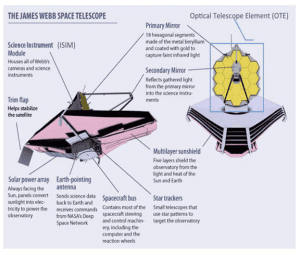Table of Contents
THE POLITY AND GOVERNANCE
1. BENAMI LAW CAN’T BE APPLIED RETROSPECTIVELY: SC
THE CONTEXT: Recently, the Supreme Court said the Section 3(2) of the Benami Transactions (Prohibition) Act 1988 as unconstitutional on the ground of being manifestly arbitrary.
THE EXPLANATION:
• A bench headed by Chief Justice said the amendment Act of 2016 to the 1988 Act is prospective in nature and it cannot apply retrospectively. Section 3(2) prescribes that whoever enters into any benami transaction shall be punishable with imprisonment for a term which may extend to three years or with fine or with both.
• Also, the bench said, “the Section 3(2) of 1988 unamended act as unconstitutional” and added that such a coercive provision can’t have a retrospective effect.
• The top court judgment came on an appeal filed by the Centre against a Calcutta High Court judgment, which held that the 2016 Amendment Act was prospective in nature.
• The amendment also increased the punishment for benami transactions from imprisonment up to three years to seven years, and a fine which may extend to 25 per cent of the fair market value of the benami property.
What is the Act about?
• In an attempt to curb black money, in July 2016, the NDA government decided to amend the original act which was subsequently passed by the Parliament of India as “The Benami Transactions (Prohibition) Amendment Act, 2016”.
• The act defines a ‘benami’ transaction as any transaction in which property is transferred to one person for consideration paid by another person.
• Such transactions were a feature of the Indian economy, usually relating to the purchase of property (real estate) and were thought to contribute to the Indian black money problem.
• The act bans all benami transactions and gives the government the right to recover property held benami without paying any compensation.
VALUE ADDITION:
What is Benami Transaction (Prohibition) Act, 1988 about?
• The Act prohibits benami transactions and provides legal provisions for confiscating benami properties.
• It defines a benami transaction as a transaction where a property is held by or transferred to a person, but has been provided for or paid by another person.
What will Benami Transactions (Prohibition) (Amendment) Act, 2016 do?
Amendment seeks to strengthen Benami Transaction (Prohibition) Act, 1988 by:
• Amend the definition of Benami transactions to widen the scope for legal action
• Specify penalties for entering into Benami transactions and
• Establish adjudicating authorities and Appellate Tribunal to deal with Benami transactions
• The Bill provides immunity under the Benami Act to those who declare their benami properties under income declaration scheme
• Under the bill, the term “property” will cover movable, immovable, tangible and intangible properties. In case of joint ownership of property, the tax payer will have to show financing sources.
Key Highlights Benami Transactions (Prohibition) Amendment Act, 2016
• Persons indulging in benami transactions may face up to 7 years’ imprisonment and fine.
• Furnishing false information is punishable by imprisonment up to 5 years and fine
• Properties held benami are liable for confiscation by government without compensation
• Initiating Officer may pass an order to continue holding property and may then refer case to Adjudicating Authority which will then examine evidence and pass an order.
• Appellate Tribunal will hear appeals against orders of Adjudicating Authority. High Court can hear appeals against orders of Appellate Tribunal.
THE SOCIAL ISSUES AND SOCIAL JUSTICE
2. SEX RATIO AT BIRTH NORMALISES SLIGHTLY: STUDY
THE CONTEXT: The latest study by the Pew Research Center has pointed out that “son bias” is on the decline in India as the average annual number of baby girls missing in the country fell from 480,000 (4.8 lakh) in 2010 to 410,000 (4.1 lakh) in 2019.
THE EXPLANATION:
HIGHLIGHTS OF THE REPORT:
• The “missing” refers to how many more female births would have occurred during this time if there were no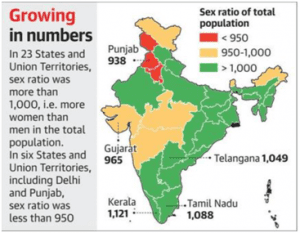 female-selective abortions. The problem began in the 1970s with the availability prenatal diagnostic technology allowing for sex selective abortions.
female-selective abortions. The problem began in the 1970s with the availability prenatal diagnostic technology allowing for sex selective abortions.
• Among the major religions, the biggest reduction in sex selection seems to be among the groups that previously had the greatest gender imbalances, particularly among Sikhs.
• The world over, boys modestly outnumber girls at birth, at a ratio of approximately 105 male babies for every 100 female babies.
• India legalized abortion in 1971, but the trend of sex selection started picking up in the 1980s due to the introduction of ultrasound scan technology.
• In the 1970s, India’s sex ratio was at par with the global average of 105-100, but this widened to 108 boys per 100 girls in the early 1980s, and reached 110 boys per 100 girls in the 1990s.
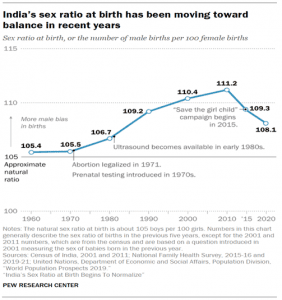
• From a large imbalance of about 111 boys per 100 girls in India’s 2011 census, the sex ratio at birth appears to have normalized slightly over the last decade, narrowing to about 109 in the 2015-16 wave of the National Family Health Survey and to 108 boys in the latest wave of the NFHS, conducted from 2019-21.
• The Pew Research Center report points out that between 2000 and 2019, nine crore female births went “missing” because of female-selective abortions. The report has also analysed religion-wise sex selection, pointing out that the gap was the highest for Sikhs.
• In the 2001 census, Sikhs had a sex ratio at birth of 130 males per 100 females, far exceeding that year’s national average of 110. By the 2011 census, the Sikh ratio had narrowed to 121 boys per 100 girls. It now hovers around 110, about the same as the ratio of males to females at birth among the country’s Hindu majority (109). Both Christians (105 boys to 100 girls) and Muslims (106 boys to 100 girls) have sex ratios close to the natural norm, and this trend is holding.
• The study points out that while the Sikhs make up less than 2% of the Indian population, they accounted for an estimated 5%, or approximately 440,000 (4.4 lakh), of the nine crore baby girls who went “missing” in India between 2000 and 2019.
• The share of missing girls among Hindus is above their respective population share.
Sex Ratio
• Sex ratio is defined as the number of females per 1000 males in a given population.
• In a society that has males and females equal in number, the sex ratio is 1:1 or 1000 females for every 1000 males.
THE INTERNATIONAL RELATIONS
3. INDIA-CHINA DISPUTE CASTS GLOOM OVER SPACE PROJECT
THE CONTEXT: Tension between India and China since May 2020 is worrying Indian astrophysicists involved in an ambitious project to install an India-made spectroscope aboard the developing Chinese space station, Tiangong.
THE EXPLANATION:
• Scientists at the Indian Institute of Astrophysics (IIA), Bengaluru, as part of a United Nations-led initiative that invites research teams from all over the world to compete for an opportunity to design payloads that will be shuttled to Tiangong aboard rockets of the Chinese Manned Space Agency.
• The project, called Spectrographic Investigation of Nebular Gas (SING), also involves collaboration with the Institute of Astronomy, Russian Academy of Sciences, and has been designed and developed by research students at the IIA. The plan is to have it ready by the year end so that it can be launched in the summer of 2023. Though the plan is on schedule, scientists at the IIA are now consulting with the Indian Space Research Organisation (ISRO) as well as the Ministry of External Affairs (MEA) on whether they are in the clear to go ahead with the project.
BORDER TENSIONS:
Chinese and Indian troops have been engaged in a prolonged stand-off in eastern Ladakh. The two sides have so far held 16 rounds of Corps Commander-level talks to resolve the stand-off, which erupted on May 5, 2020, following a violent clash in the Pangong lake area.
• “According to the sources from MEA, at the moment [the India-China] relationship is going through an extremely difficult phase after what China did at the border”.
• The SING project would be the first space-collaboration involving India and China, and primarily deals with sending and positioning a spectrograph, an instrument that splits light into constituent frequencies and wavelengths, to study ultraviolet radiation. This will help analyse the make-up and sources of interstellar gas in the region that swept by the space station as it orbits around the earth.
• India and China have been collaborators in the past on research projects such as the Giant Metre Wave Radio Telescope, a Pune-based observatory that’s employed by astrophysicists across the world to study radiation at metre-scale resolutions to observe and analyse stars and galaxies.
VALUE ADDITION:
What is the Tiangong space station?
• Tiangong space station, or “Heavenly Palace”, is China’s new permanent space station. The country has previously launched two temporary trial space stations, named as Tiangong-1 and Tiangong-2.
• The new lab Wentianis the second of three key modules to Tiangong. The first key module Tianhe – which contains living quarters for crew members – was sent into orbit in April 2021. The other key module, Mengtian science lab, is due to be launched by the end of 2022.
• China has big ambitions for Tiangong. The station will have its own power, propulsion, life support systems and living quarters. It is also designed to provide refuelling power to China’s new space telescope, called Xuntian, which will fly close to the space station next year.
4. REINVIGORATING THE CHABAHAR PORT
THE CONTEXT: Amid the visit of Union Minister of Ports, Shipping and waterways, the Union government has revved up its interest in using Iran’s Chabahar port to connect to Afghanistan and Central Asia for trade.
THE EXPLANATION:
India’s strategic vision for Chabahar
• When the first agreement for Chabahar was signed in 2003, the plan had a three-fold objective:
o to build India’s first offshore port and to project Indian infrastructure prowess in the Gulf;
o to circumvent trade through Pakistan, given the tense ties with India’s neighbour and build a long term, sustainable sea trade route;
o to find an alternative land route to Afghanistan, which India had rebuilt ties with after the defeat of the Taliban in 2001.
Subsequently the Indian government constructed the Zaranj -Delaram Highway in Afghanistan’s South, which would help connect the trade route from the border of Iran to the main trade routes to Herat and Kabul, handing it over to the Karzai government in 2009.
• In 2016 India signed the agreement to develop Chabahar port, as well as the trilateral agreement for trade through Chabahar with Afghanistan.
• The India Ports Global Chabahar Free Zone (IPGCFZ) authority took over the operations of the port in 2018.
• In the last few years, a fourth strategic objective for the Chabahar route has appeared, with China’s Belt and Road Initiative making inroads in the region.
o The government hopes to provide Central Asia with an alternate route to the China-Pakistan Economic Corridor (CPEC) through Iran for future trade.
Why is the Chabahar dream taking so long to realise?
• The biggest issue has been over Iran’s relationship with western countries, especially the United States.
• In years when western sanctions against Iran increased, the Chabahar project has been put on the back-burner, while in the years when nuclear talks that resulted in the Joint Comprehensive Plan of Action (JCPOA) in 2015 came into being, the Chabahar port has been easier to work on.
• In 2018, the U.S. Trump administration put paid to India’s plans by walking out of the JCPOA and slapping new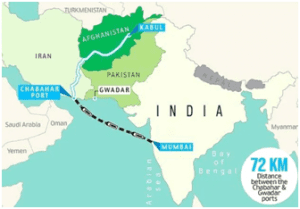 sanctions on dealing with Iran.
sanctions on dealing with Iran.
• This led to the Indian government “zeroing out” all its oil imports from Iran, earlier a major supplier to India, causing a strain in ties.
• It has been difficult to source equipment for the port construction from infrastructure companies that continue to fear secondary sanctions, as well as to engage shipping and insurance companies for trade through Chabahar.
• The Indian government also snapped ties with Afghanistan after the Taliban takeover in August 2021, which put an end to the humanitarian aid of wheat and pulses that was being sent to Kabul via Chabahar.
• When India restarted wheat aid to Afghanistan this year, it negotiated with Pakistan to use the land route instead.
• With the government now reopening the Indian Embassy in Kabul, and establishing ties with the Taliban government, it is possible that the Chabahar route will once again be employed.
THE SCIENCE AND TECHNOLOGY
5. DRDO, INDIAN NAVY TEST INDIGENOUS MISSILE
THE CONTEXT: The Defense Research and Development Organization (DRDO) and the Indian Navy successfully flight-tested the indigenously developed Vertical Launch Short Range Surface-to-Air Missile (VL-SRSAM) from the Integrated Test Range (ITR) at Chandipur off the coast of Odisha.
THE EXPLANATION:
What is VL-SRSAM?
• The VL-SRSAM, a ship-borne weapon system, is meant for neutralising various aerial threats at close ranges, including sea-skimming targets, and was the last test-fired in June 2021.
• It has been designed and developed jointly by three facilities of the Defense Research and Development
Organization for deployment of Indian Naval warships.
• The missile has the capability of neutralizing various aerial threats at close ranges including sea-skimming targets.
• The tactic of sea skimming is used by various anti-ship missiles and some fighter jets to avoid being detected by the radar’s onboard warships.
• For this, these assets fly as close as possible to sea surface and thus are difficult to detect and neutralize.
Design of VL-SRSAM
• The missile has been designed to strike at the high-speed airborne targets at the range of 40 to 50 km and at an altitude of around 15 km.
• Its design is based on Astra missile which is a Beyond Visual Range Air to Air missile.
• Two key features of the VL-SRSAM are cruciform wings and thrust vectoring.
• The cruciform wings are four small wings arranged like a cross on four sides and give the projective a stable aerodynamic posture.
• The thrust vectoring is an ability to change the direction of the thrust from its engine control the angular velocity and the attitude of the missile.
6. JAMES WEBB SPACE TELESCOPE: NEW IMAGE OF JUPITER
THE CONTEXT: Recently, the James Webb Space Telescope, NASA’s latest and most powerful telescope, has captured new images of our solar system’s largest planet, Jupiter, presenting it in a never before seen light.
THE EXPLANATION:
• The photographs published have captured a new view of the planet, presenting in detail its massive storms, colourful auroras, faint rings and two small moons — Amalthea and Adrastea.
• According to NASA we are familiar with the yellow and reddish-brown gas giant, the telescope’s Near-Infrared Camera, with its specialized infrared filters, has shown Jupiter encompassed in blue, green, white, yellow and orange hues. Since infrared light is not visible to the human eye, the images were artificially coloured to match those on the visible spectrum, so that the planet’s distinctive features could stand out.
• Jupiter’s famous Great Red Spot, a storm so big that it could swallow Earth, appeared bright white in the image, since it was reflecting a lot of sunlight, the space agency stated.
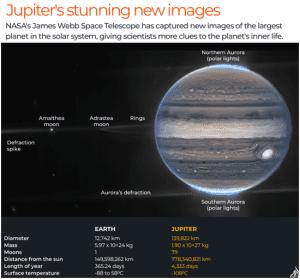
VALUE ADDITION:
About Webb Space Telescope:
• It is the most powerful infrared telescope launched by NASA. The telescope is the result of an international collaboration between NASA, the European Space Agency (ESA), and the Canadian Space Agency.
• Webb will reveal new and unexpected discoveries, and help humanity understand the origins of the universe and our place in it. The telescope will also study the atmospheres of a wide diversity of exoplanets.
Exoplanets :
• An exoplanet is any planet beyond our solar system. Most orbit other stars, but free-floating exoplanets, called rogue planets, orbit the galactic centre and are untethered to any star.
• Exoplanets are made up of elements similar to those of the planets in our solar system, but their mixes of those elements may differ. Some planets may be dominated by water or ice, while others are dominated by iron or carbon.
Objectives of the Webb space telescope:
• Search for the galaxies that formed the very beginning after the Big Bang.
• Determine the evolution of galaxies from their earlier formation until now.
• Observe the stages of the formation of stars until the formation of planetary systems.
• Measure the physical and chemical properties of planetary systems and investigate the potential for life in such systems.
